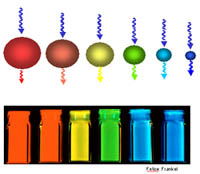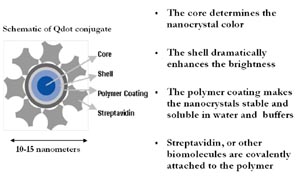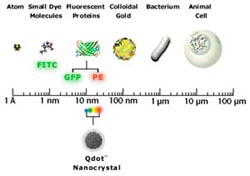Home > Best of Nanotechnology > 2003
Best of Nanotechnology - 2003 Awards
For the past six years the team at Nanotechnology Now has tracked the thousands of websites, individuals, businesses, and government and educational institutions that exist in the nanospace. We read about and report on them every day, 365 days a year. By interviewing them, and covering their news, opinions, discoveries, triumphs and failures, we have come to appreciate a few above the rest.
If you have another favorite, please
us and it will be reviewed for our "Best of 2004."
Go directly to the section:
MEDIA & INFORMATION |
PRODUCTS |
PROMISING DISCOVERIES |
NEWSLETTERS, DISCUSSION GROUPS & BLOGS |
POLICY MAKERS |
BIG THINKERS |
TOOLS |
BOOKS |
NOTABLES
Best of the Best and Advocate

|
The Center for Responsible Nanotechnology™ (CRN) A non-profit organization, formed to advance the safe use of molecular nanotechnology, CRN was founded by Chris Phoenix and Mike Treder in December 2002. The vision of CRN is a world in which nanotechnology is widely used for productive and beneficial purposes, and where malicious uses are limited by effective administration of the technology.
|
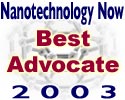
|
ADVOCATE (a person who pleads for a cause or propounds an idea) Runners-Up:
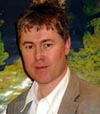
Tim Harper - Europe
Founder & CEO of CMP Cientifica, and the Co-Author of the Nanotechnology Opportunity Report™. He is also the Executive Director of European NanoBusiness Association and an advisor to the US NanoBusiness Alliance. He contributes a weekly column to the Institute of Physics Nanotechweb site. In 1997 he founded CMP Cientifica, which organises Europe's largest scientific nanotechnology conference, TNT 200x. The company also manages both the Phantoms network, which coordinates European nanoelectronics research, and the NanoSpain network which links the Spanish scientific nanotechnology community.

nanoSIG
nanoSIG™ is the leading Northern California based membership organization focused on the commercial development of nanotechnology. Based at Nasa/Ames, they are part of a global nanotechnology network and act as a liaison to European and Asian counterparts. nanoSIG™ delivers education, information, & networking via nanotechnology domain Briefings; Conferences, Meetings, and eMeetings; Database & Web services; Global Activist Network; and detailed Marketing & Technical Reports on various nanotechnology domains.

Steve Jurvetson
Managing Director of Draper Fisher Jurvetson. Draper Fisher Jurvetson of Redwood City, is recognized as one of the foremost venture capital units investing in nanotech startups. A Stanford graduate in engineering and business, Jurvetson saw seven of his communications chip designs fabricated as an R&D engineer at Hewlett-Packard. Jurvetson was chosen by Forbes as one of "Tech's Best Venture Investors," by the VC Journal as one of the "Ten Most Influential VCs," and by Fortune as part of their "Brain Trust of Top Ten Minds." Articles include: The New Future and Transcending Moore's Law.

Foresight Institute
Once again, the folks at Foresight continue to inform, research, and call to action. They have been, and continue to be, the leaders in getting the word out to the public. Based on the efforts of Foresight Chairman and Founder Eric Drexler, President Christine L. Peterson, Vice President Ralph C. Merkle, Webmaster James Lewis, and the rest of the team at Foresight, this site has become known as a catalyst for debate, and is generally recognized as the most complete technical reference as well.

Howard Lovy Independent nanotechnology information and commentary
Choice posts in 2003 include - but are not linited to - Stairway to Heaven and Apocalypse Nano and The Hulk, Prince Charles and other scary things and 2003: The Year of the Straw NanoMan
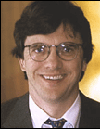
Glenn Harlan Reynolds
Read his well-crafted opinions at Instapundit.

Lerwen Liu - Asia
President nABACUS Partners, and author Asia Pacific Nanotech Weekly.

Neil Gordon - Canada
President Canadian NanoBusiness Alliance, and Partner - Nanotechnology Sygertech. Neil specializes in the commercialization of nanotechnology and in advocating nanotechnology in Canada. Articles include: Tips for Bringing Nanotech Products to Market, Five Ingredients for Financing Nanotech Ventures, Nanomedicine Taxonomy, and Nanotechnology as a Disruptive Technology.
Back To Top
MEDIA & INFORMATION
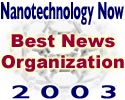
|
Nanotechweb Featuring articles by Tim Harper (founder of CMP Cientifica, Executive Director of the European NanoBusiness Association, and an advisor to the US NanoBusiness Alliance), Liz Kalaugher, and other contributing writiers, and TNT Weekly, Paul Holister contributing editor. |
|
Runners-Up:
Back To Top
PRODUCTS
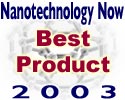
|
For their pioneering work with nanocrystals, we present to Quantum Dot Corporation the "Best Product" award for 2003. For more information, visit www.qdots.com |
|
Founded in 1998, Quantum Dot Corporation (QDC) develops and markets novel solutions for biomolecular detection. QDC's products and services employ quantum dot (Qdot®) particles, tiny semiconductor crystals that emit light brightly in a range of sharp colors. These nanometer-sized Qdot particles have unique, highly desirable properties that make them a superior detection platform for biology. QDC has invested many years in perfecting the methods for synthesis of high quality, high brightness quantum dots for biology. With enabling applications in life science research, in vitro diagnostic testing, and in vivo imaging, Qdot nanocrystals are set to revolutionize biomolecular detection.
![]() Quantum Dot Corporation Unveils Two Nanotechnology Products Quantum Dot Corporation (QDC) announces two additions to its nanocrystal-based family of fluorescent labels: the Qtracker™ 655 Kit for loading Qdot™ nanocrystals into live cells and the Qdot 705 streptavidin conjugate for ultra-bright, near infra-red bio-detection. The Qtracker 655 Kit is the first in a new line of labeling reagents designed for introducing Qdot nanocrystal-based fluorochromes into live cells. QDC also introduces the Qdot 705 Streptavidin Conjugate, the brightest near-infrared fluorophore available by far.
Quantum Dot Corporation Unveils Two Nanotechnology Products Quantum Dot Corporation (QDC) announces two additions to its nanocrystal-based family of fluorescent labels: the Qtracker™ 655 Kit for loading Qdot™ nanocrystals into live cells and the Qdot 705 streptavidin conjugate for ultra-bright, near infra-red bio-detection. The Qtracker 655 Kit is the first in a new line of labeling reagents designed for introducing Qdot nanocrystal-based fluorochromes into live cells. QDC also introduces the Qdot 705 Streptavidin Conjugate, the brightest near-infrared fluorophore available by far.
Quantum Dot: A nanocrystal. Since the term emphasizes the quantum confinement effect it typically refers to the sub-class of nanocrystals that are small enough to exist in the quantum confinement regime, and more typically refers to fluorescent nanocrystals in the quantum confined size range.
Runners-up: To see our list of 25 runners-up, click here
Back To Top
PROMISING DISCOVERIES
Medical
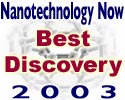
|
"Imagine if cancer could become trivial." Naomi Halas
For furthering our understanding of the potential of "nanoshells," while at the same time lessening our worries about cancer, this year's "Best Discovery" Award goes to Naomi Halas and Jennifer West for their cancer-fighting gold nanoparticles. One of their visions: no less than single visit diagnosis and treatment of cancer.
|
Runners-up: To see our list of 61 runners-up, click here
Back To Top
NEWSLETTERS, DISCUSSION GROUPS & BLOGS
From CMP Científica, and edited by Paul Holister.
A twice monthly webpage and voice report, dealing with the topics, events, and science of the day, and theorizing about possibilities. Jeffrey R. Harrow does an outstanding job of putting it all together for us, and presenting it in a way that is easy to understand. He stimulates the mind, piques the curiosity, and generally gets you more interested than you were before you came to the party.
Singularity, Robotics, AI, Immortality, Nanotech, Cloning, and more. Edited by Amara D. Angelica.
A nanotech discussion group dedicated to a fair and open exchange of ideas.
From the Editor of Small Times. Read all about what is on Howard's mind - what he cannot print at Small Times.
News and notes about the ongoing work of the Center for Responsible Nanotechnology (CRN).
News and discussions of coming technologies. Contains discussion and posts, from Medicine to Investment to Future Applications.
An insider's blog on the science, markets, and undiscovered trends of nanotech.
Back To Top
BIG THINKERS

K. Eric Drexler |
K. Eric Drexler: Dr. Drexler is a researcher concerned with emerging technologies and their consequences for the future. In the mid 1980s, he introduced the term 'nanotechnology' to describe atomically precise molecular manufacturing systems and their products. Advanced nanotechnologies will make possible many dreams (and nightmares) first articulated in the literature of science fiction. He is a founder and current Chairman of the Foresight Institute, a nonprofit educational organization established to help prepare for advanced technologies. He wrote Engines of Creation (1986) to introduce a broad audience to the prospect of advanced nanotechnologies -- their nature, promise, and dangers -- and Nanosystems (AAP 1992 Most Outstanding Computer Science Book) to provide a graduate-level introduction to the fundamental physical and engineering principles of the field. In 2003, he debated Noble Prize winner Richard E. Smalley on the question "Are molecular assemblers physically possible?." While there was no winner, and no loser, Dr. Drexler succinctly presented his case, and in all but the minds of a very few, clearly made the case that his position ought to at least be tested. |

Ray Kurzweil |
Ray Kurzweil: Ray was the principal developer of the first omni-font optical character recognition, the first print-to-speech reading machine for the blind, the first CCD flat-bed scanner, the first text-to-speech synthesizer, the first music synthesizer capable of recreating the grand piano and other orchestral instruments, and the first commercially marketed large-vocabulary speech recognition. Ray has successfully founded and developed nine businesses in OCR, music synthesis, speech recognition, reading technology, virtual reality, financial investment, medical simulation, and cybernetic art. All of these technologies continue today as market leaders. Ray's Web site, KurzweilAI.net, is a leading resource on artificial intelligence. Read more about Ray, here.
|

Jeff Harrow |
Jeff Harrow:
Harrow Technology Report
|
Back To Top
TOOLS & TOOL MAKERS
![]() Quantum Dot Corporation (QDC) "Quantum Dot Corporation (QDC) develops and markets novel solutions for biomolecular detection. QDC's products and services employ quantum dot (Qdot®) particles, tiny semiconductor crystals that emit light brightly in a range of sharp colors. These nanometer-sized Qdot particles have unique, highly desirable properties that make them a superior detection platform for biology." See Science Magazine Recognizes Quantum Dot Research as One of the Top Ten Scientific Breakthroughs of the Year
Quantum Dot Corporation (QDC) "Quantum Dot Corporation (QDC) develops and markets novel solutions for biomolecular detection. QDC's products and services employ quantum dot (Qdot®) particles, tiny semiconductor crystals that emit light brightly in a range of sharp colors. These nanometer-sized Qdot particles have unique, highly desirable properties that make them a superior detection platform for biology." See Science Magazine Recognizes Quantum Dot Research as One of the Top Ten Scientific Breakthroughs of the Year
![]() Zyvex "We started Zyvex to develop practical uses for molecular nanotechnology to transofrm how we make physical goods — creating clean, flexible, and powerful manufacturing for the 21st century. Zyvex is moving along that path rapidly, with current product offerings in R&D tools, nanomaterials, and assembled micromachines. Our team is dedicated to nanotechnology because we believe it will fulfill its promise to transform the world in profound ways."
Zyvex "We started Zyvex to develop practical uses for molecular nanotechnology to transofrm how we make physical goods — creating clean, flexible, and powerful manufacturing for the 21st century. Zyvex is moving along that path rapidly, with current product offerings in R&D tools, nanomaterials, and assembled micromachines. Our team is dedicated to nanotechnology because we believe it will fulfill its promise to transform the world in profound ways."
![]() Biophan Technologies "NanoView is intended to utilize nanomagnetic particles as contrast agents that preferentially bind to tissues of diagnostic interest, creating improved detail and contrast in images. If successful, this technology would improve signal intensity and permit the use of multiple markers."
Biophan Technologies "NanoView is intended to utilize nanomagnetic particles as contrast agents that preferentially bind to tissues of diagnostic interest, creating improved detail and contrast in images. If successful, this technology would improve signal intensity and permit the use of multiple markers."
![]() FEI Structural Process Management Solutions for Semiconductors, Data Storage, Materials, Science, and Life Science.
FEI Structural Process Management Solutions for Semiconductors, Data Storage, Materials, Science, and Life Science.
![]() Veeco Metrology Group Metrology and process equipment systems for industry leaders in the semiconductor, data storage, telecom/wireless and scientific/research markets.
Veeco Metrology Group Metrology and process equipment systems for industry leaders in the semiconductor, data storage, telecom/wireless and scientific/research markets.
![]() Nanoscience Instruments
Nanoscience Instruments
Phoenix, AZ, USA. Provides high quality nanoscience instrumentation, accessories and supplies to educators, researchers and engineers.
![]() The Nanomanipulator from the Center for Computer Integrated Systems for Microscopy and Manipulation (CISMM) at UNC Chapel Hill. Part of the Nanoscale Science Research Group (NSRG).
Images & Movies
The Nanomanipulator from the Center for Computer Integrated Systems for Microscopy and Manipulation (CISMM) at UNC Chapel Hill. Part of the Nanoscale Science Research Group (NSRG).
Images & Movies
Back To Top
POLICY MAKERS
Authorizing nearly $3.7 billion over four years, the U.S. House of Representatives passed the 21st Century Nanotechnology Research and Development Act (PDF, 64 KB), and on December 3rd, 2003, President Bush signed it into law. Although the yearly budget is only a little more than for previous years, the important thing is that it will make the effort permanent, creating the National Nanotechnology Research Program (NNPR) to replace the expiring National Nanotechnology Initiative (NNI). While we have misgivings relating to the omission of a study of the feasibility of molecular manufacturing (which was included in an earlier version of the bill - see Molecular Nanotechnology - Omission in the 21st Century Nanotechnology Research and Development Act, we believe this bill is a step in the right direction. To be congratualted for their efforts are Sen. Ron Wyden (D-Ore.), Sen. Joe Lieberman (D-Conn.), Sen. George Allen (R-Va.), and U.S. Rep. Mike Honda (D-Calif.). See Nanotech R&D act becomes law for details.
While not a policy-making group, the newly formed Nanotechnology Technical Advisory Group (NTAG) is charged with providing technical information on nanotechnology to the President's Council of Advisors on Science and Technology (PCAST). The NTAG consists of experts representing a range of disciplines, such as bionanotechnology, drug delivery, biosensers, MEMS, sensing, chemistry, physics, business, commercial and government. Given that they will advise those who advise the President, count on them to have some influence. We'll keep a watch out, and report on them when policy is made.
Back To Top
BOOKS
Some old, some new, all valuable and informative. Click here to see the whole listing of our picks for 2003.Our choices for the best books of 2003:
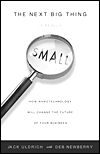 The Next Big Thing Is Really Small Jack Uldrich Deb Newberry |
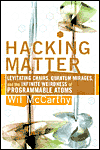 Hacking Matter Wil McCarthy |
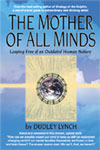
The Mother of All Minds Dudley Lynch |
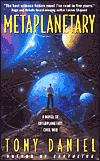 Metaplanetary Tony Daniel |
See our Nanotechnology Books section for a comprehensive listing of other science and science fiction books.
Back To Top
NOTABLES

Click to enlarge. Pat Rawling, Artist. Concept of a space elevator as viewed from geostationary transfer station. |
The Space Elevator To learn more, visit the Institute for Scientific Research |
|
Extropy - The International Transhumanist Organization
|

|
![]() Using nanotubes and etched silicon, UC Berkeley physicists build world's smallest motor Only 15 years after University of California, Berkeley, engineers built the first micro-scale motor, a UC Berkeley physicist has created the first nano-scale motor - a gold rotor on a nanotube shaft that could ride on the back of a virus. "It's the smallest synthetic motor that's ever been made," said Alex Zettl, professor of physics at UC Berkeley and faculty scientist at Lawrence Berkeley National Laboratory. "Nature is still a little bit ahead of us - there are biological motors that are equal or slightly smaller in size - but we are catching up."
Using nanotubes and etched silicon, UC Berkeley physicists build world's smallest motor Only 15 years after University of California, Berkeley, engineers built the first micro-scale motor, a UC Berkeley physicist has created the first nano-scale motor - a gold rotor on a nanotube shaft that could ride on the back of a virus. "It's the smallest synthetic motor that's ever been made," said Alex Zettl, professor of physics at UC Berkeley and faculty scientist at Lawrence Berkeley National Laboratory. "Nature is still a little bit ahead of us - there are biological motors that are equal or slightly smaller in size - but we are catching up."
|
|
||
|
|
||
| The latest news from around the world, FREE | ||
|
|
||
|
|
||
| Premium Products | ||
|
|
||
|
Only the news you want to read!
Learn More |
||
|
|
||
|
Full-service, expert consulting
Learn More |
||
|
|
||



